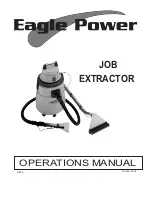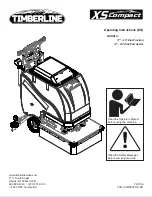
Page 4 of 10
SECTION 4 – OPERATION
4.1 To Operate Safely
Read and understand Section 1: Safety Precautions and Section 4: Operation before use
Read and understand all Material Safety Data Sheets and Manufacturer’s instructions of all
process materials, consumables, and equipment used in conjunction with this equipment.
Keep away from all mechanical moving parts including motor, gears, and other pinch points.
Do not use product without first confirming if a Spark Arrestor is required and installed for the type
of dust, or fumes you are extracting and/or collection. If you are unsure, call a Diversi-Tech
representative at 1-800-361-3733.
4.2 Controls
(1)
Power Switch – this switch has two positions;
ON and OFF.
(2)
Filter Monitoring Light – lamp lights when the helical
sensor detects that filter maintenance is required.
4.3 Pre-Use Checklist
Prior to use in your application, turn the unit ON, and perform a function test. To do so:
1.
Turn switch to ON position
2.
LOOK: Is the unit level, stable, and that nothing is obstructing the extraction path.
3.
LISTEN: Does the motor and suction sound smooth and within expected volumes.
4.
FEEL: Place your hand on top of the unit and sense for unexpected vibration. Place you hand in front of
the intake hood/surface and sense for expected level(s) of suction.
Inform all potential users of this equipment where they may find and review this manual.
4.4 Principles of Operation
This product is designed to capture and clean smoke and dust from light-duty welding, soldering, and grinding applications.
When operating, air is drawn in to the nozzle, passes through the 2” diameter hose, then through the air cleaner’s filtration
system, and is finally exhausted through the bottom discharge. When the hood is placed sufficiently close to the source of
dust and smoke, three stages of filtration work to clean pollution from the air. First, a pre-filter section collects the large dust
particles. Second, smaller particles are trapped in the fibers of the cartridge filter with an efficiency specified in Section 2.3.
Third, filtered air then passes through a carbon filter to remove any remaining odor before exhausting into the room.
This product consists of four basic components:
1.
A cabinet for housing all components
2.
A blower
3.
Electrical assemblies
4.
Collecting assemblies (filters)






























